Tree frogs are found throughout most of North America, especially in the central and southeastern U.S. states. There are 14 species of tree frogs in Texas and all of them are in the Family Hylidae. These frogs are small, can be camouflaged, and are excellent climbers due to their large toepads with adhesive disks.
Tree frogs start as tadpoles and breed near bodies of water, so you often find them in trees near these breeding sites. Texas borders the Gulf of Mexico and contains numerous major rivers, such as the Rio Grande, Colorado River, Red River, and the Brazos River. These water bodies provide an optimal ecosystem for semi-aquatic wildlife like the tree frog.
Read on to learn more about the 14 types of tree frogs in Texas.
Tree Frogs in Texas
The 14 different species of tree frogs in Texas are Canyon tree frog, Eastern Gray tree frog, Cope’s Gray tree frog, Squirrel tree frog, Mexican tree frog, Spring Peeper, Northern Cricket frog, Blanchard’s Cricket frog, Green tree frog, Spotted Chorus frog, Strecker’s Chorus frog, Cajun Chorus frog, Upland Chorus Frog, and Cuban tree frog.
1. Canyon Tree Frog

Scientific name: Hyla arenicolor
Canyon Tree Frogs are nocturnal and enjoy living by creeks in rocky canyons in the Big Bend area of Texas. They can grow up to 2.2 inches in length as adults. Their coloring is grey-green, brown, or gray-brown with darker blotches. Although those living near limestones are lighter in color, sometimes pink.
2. Eastern Gray Tree Frog
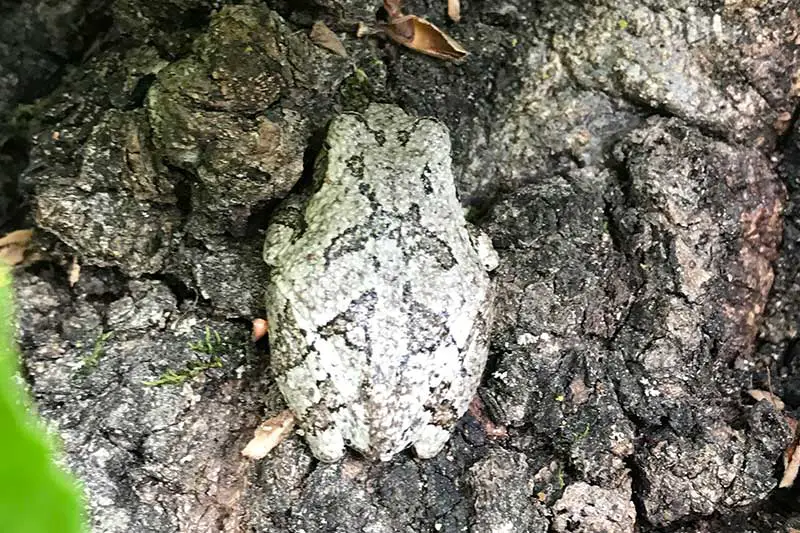
Scientific name: Hyla veriscolor
Eastern Gray tree frogs can change color from nearly white to nearly black for camouflage. Their unique features include a dark bandish pattern on their legs contrasted with bright orange or yellow undersides of their legs and arms. These frogs grow in length between 1.26 to 2.4 inches. Females are usually larger than males and have a white throat but do not call. They live in the eastern half of Texas.
3. Cope’s Gray Tree Frog
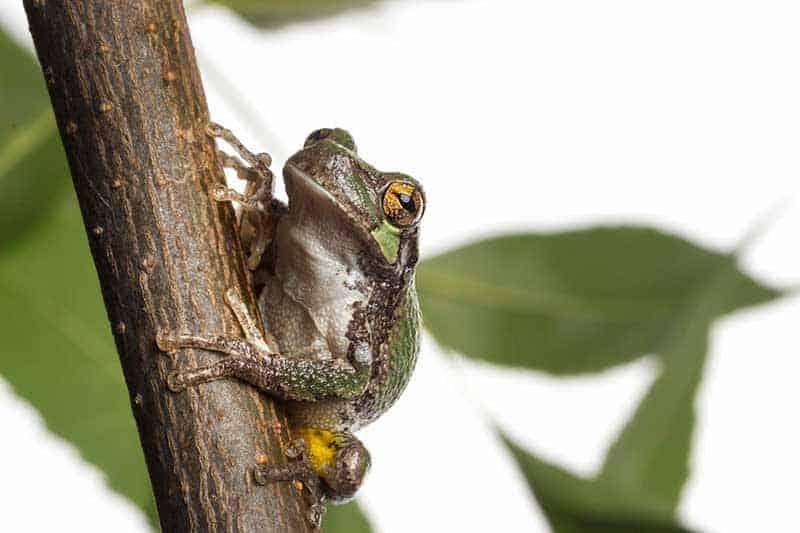
Scientific name: Hyla chrysoscelis
The Cope’s Gray tree frog is smaller and has smoother skin than the Gray tree frog. Adults grow in length between 0.78 and 1.9 inches. They also have noticeably different calls, with the Cope’s Gray tree frog call shorter and faster. You can find these frogs in the eastern half of Texas.
4. Squirrel Tree Frog

Scientific name: Hyla squirella
The Squirrel tree frog is green, gray, tan, or brown with splotches and smooth skin. They can vary in pattern from plain or spotted to having whitish stripes on their sides. Adults usually grow to a length of 1 or 1.5 inches.
These frogs are in the southeastern portion of Texas, including on buildings and in urbanized areas. Their name comes from the squirrel-like raspy call they make during rainstorms.
5. Mexican Tree Frog
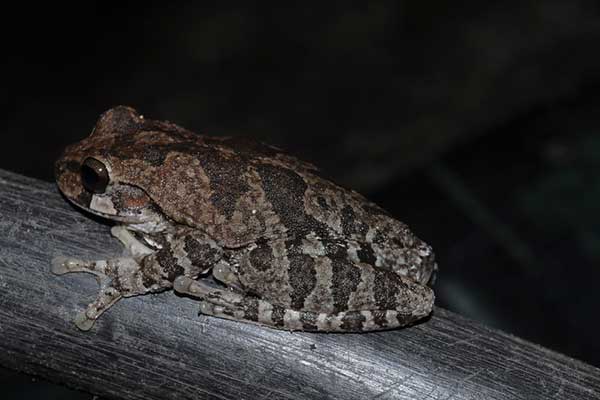
Scientific name: Smilisca baudinii
The Mexican tree frog is the largest tree frog that is native to the United States. Adults grow in length up to 3 or 4 inches. The Texas Parks and Wildlife Department considers it a threatened species and the state fully protects it. You can find them in the most southern tip of Texas. They have smooth yellow, gray, green, or dark brown skin with a light spot under their eyes.
6. Spring Peeper
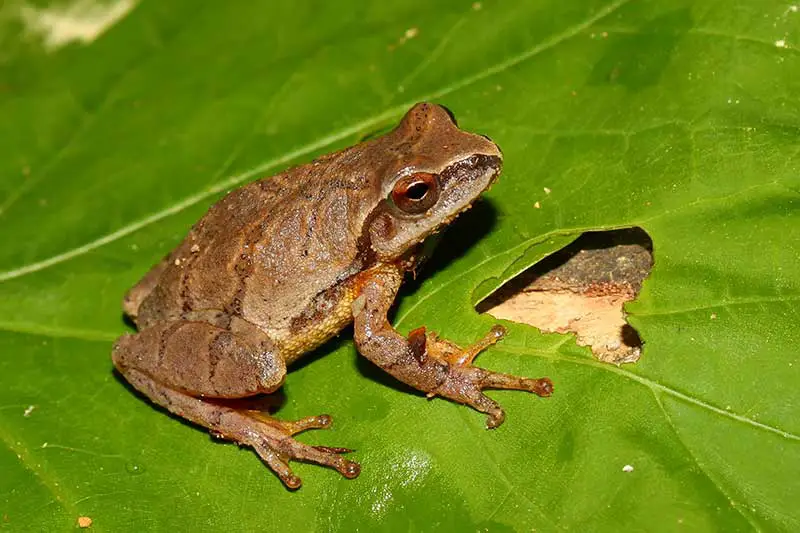
Scientific name: Pseudacris crucifer
The Spring Peeper varies in color from dark brown to tan, with smooth skin and an X-shaped pattern on its back. They can make themselves darker or lighter to camouflage. These frogs are small, varying in length between 0.75 to 1.5 inches. However, they are cold tolerant due to the natural “antifreeze” in their blood. In Texas, they are restricted to the eastern quarter of the state.
7. Northern Cricket Frog
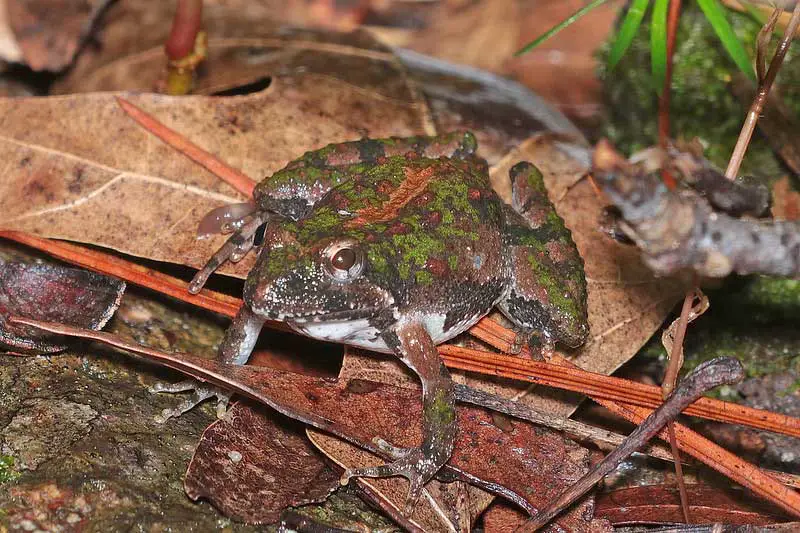
Scientific name: Acris crepitans
The Northern Cricket frog’s color ranges from a mixture of red, yellowish-orange, and black. Adult males average 1.5 inches in length and females are slightly larger. Despite their small size, they can jump as far as 6 inches. You can find them throughout Texas, except in the far western Trans-Pecos and western panhandle.
8. Blanchard’s Cricket Frog
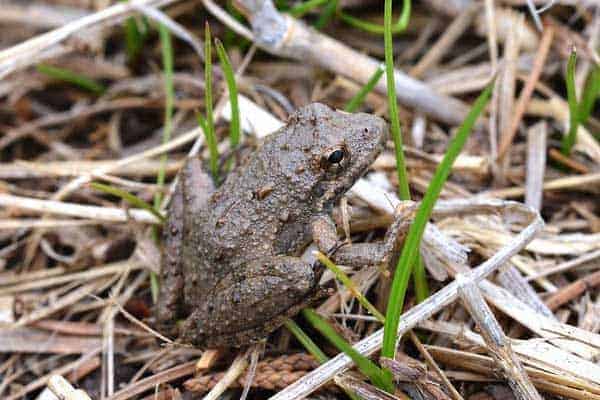
Scientific name: Acris blanchardi
The Blanchard’s Cricket frog is very small, with adults growing up to 0.6 inches in length. Their average lifespan is around one year only. Their skin is warty and brown, tan, gray, or olive green with dark bands on their legs. These frogs can also easily get diseases as their skin is heavily vascularized, allowing substances to get into their bodies. You can find them throughout Texas except in the panhandle and western parts of the state.
9. Green Tree Frog

Scientific name: Hyla cinerea
The Green Tree frog has a slender, smooth body that’s bright to dark green or grayish. Their sides are usually marked with white stripes with crisp black borders. Adults grow to a size of 1 to 2.5 inches in length.
These frogs can be found in trees near permanent water bodies. Although they were originally restricted to the eastern third of Texas, they have recently also been introduced to Big Bend National Park. The Green Tree frog call is a nasal quoonk-quoonk repeated up to 75 times per minute.
10. Spotted Chorus Frog
Scientific name: Pseudacris clarkii
The Spotted Chorus frog is olive green or gray with light green mottling on its back. You can find these frogs from north to south Texas, except the far east and west, including the Rio Grande valley. They are nocturnal tree frogs, growing up to 1.25 inches in length. You can hear their loud calls at night sounding like a rapid “whank-whank-whank.”
11. Strecker’s Chorus Frog
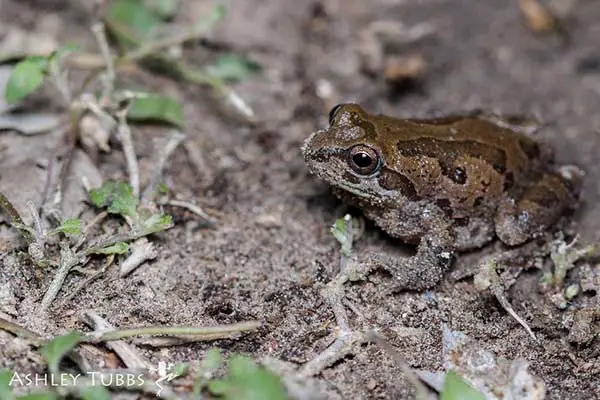
Scientific name: Pseudacris streckeri
The Strecker’s Chorus frog varies in color from green and brown to gray, with a distinctive dark strip underneath the eye and long blotches on its back. Their size is around 1.5 inches. You can find them in the eastern half of Texas and hear their bell-like whistle when they call.
12. Cajun Chorus Frog
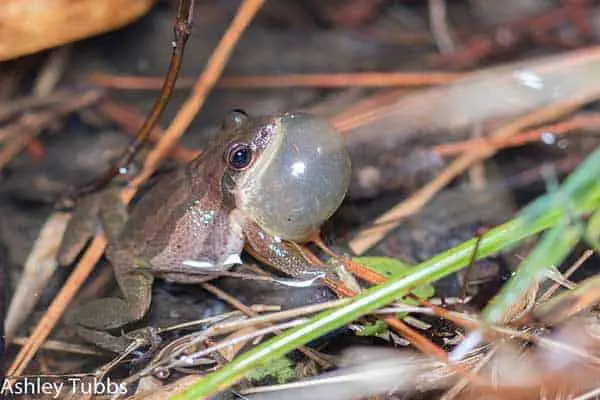
Scientific name: Pseudacris fouquettei
Cajun Chorus frogs have a brown or brownish-gray color and dark stripes with irregular edges. However, some have three rows of spots. Adult males can reach 1.25 inches in length, while females are slightly smaller. You can find these frogs from eastern to central Texas. They typically live in vegetation at ground level.
13. Upland Chorus Frog

Scientific name: Pseudacris feriarum
The Upland Chorus frog has a brown to grayish body with tan or brown stripes along its back and upper legs. They can grow up to 1.4 inches in length.
These frogs are found in eastern Texas. They breed throughout the year but more frequently during the cooler, rainy periods. Females lay clusters of around 60 eggs and can lay up to 1,000 eggs at a time.
14. Cuban Tree Frog

Scientific name: Osteopilus septentrionalis
The Cuban tree frog has a possible isolated population in southeastern Texas. They are an invasive species that eat native frogs, small snakes, and small lizards. They breed in shallow fish-free water and move in large numbers to breeding sites after early-season rains from March to October.
These frogs’ colors vary from whitish or gray to brown or green with dark blotches or stripes. Their toepads are large and wider than native tree frog toepads. Usually, they are 1.5 to 3 inches in length but can grow up to 5.5 inches.


